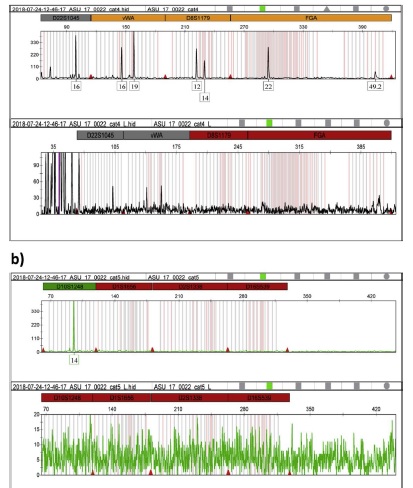Forensic Genetics: DNA RECOVERY FROM BURNED AND DEGRADED BONE
DNA analysis is often a vital step in identifying victims of crime and missing persons. In many
forensic cases – particularly if the remains of the individual have been buried, exposed to the sun
and elements, or burned in fire – the DNA molecule may be damaged. Standard forensic DNA analysis
may be unable to recover usable DNA, preventing identification. Ancient DNA analyses, however,
routinely deal with degraded DNA recovered from archaeological and paleoanthropological contexts.
Ancient DNA methods are ideal for extracting and recovering DNA from cold forensic cases. The Stone
Lab has partnered with the Maricopa County Office of the Medical Examiner on several studies to
pioneer the use of ancient DNA methods for DNA extraction, amplification, and library construction
on human tissues obtained from forensic contexts. This work is in collaboration with Dr. Laura
Fulginiti at the Maricopa County Office of the Medical Examiner and Dr. Jane Buikstra at the Center
for Bioarchaeological Research at ASU.
DNA Recovery from Burned Bone
For this research, we are investigating the success of DNA recovery from burned human tissues from
forensic contexts. According to the US Fire Administration, over 3,500 people in the United Stated
died from fires in 2017. In many of these cases, DNA evidence is required to identify the victims.
High temperature fires can damage the DNA, making identification more difficult. The goal of this
project is to assess systematically how to best recover DNA from human bone that has been burned to
varying degrees including smoked, charred, and calcined bone. Different methods for extracting DNA
are being tested to assess which method works best. Our findings will also assist with victim
identification by advising law enforcement and forensic personnel which tissues are going to be best
able to produce DNA for identification. The methods developed from this project will help law
enforcement identify previously unidentified human remains. Funding is for this research is from the
National Institutes of Justice (2016-DN-BX-0158 and 2019-DU-BX-0044)
DNA recovery from Degraded Bone
This research examines DNA recovery from harsh environments where human tissue and DNA may become
degraded such as burial underground or on the surface of the earth and exposed to the elements. Of
particular interest are human remains recovered from desert contexts where the teeth and bones are
exposed to intense heat, aridity, and UV radiation from the sun. This project also aims to identify
victims in cases where standard forensic DNA methods were previously unsuccessful. This research has
the following objectives: 1) Assess how physical characteristics of degraded human skeletal and
dental tissues such as bleaching, cracking, and carnivore scavenging may correspond to DNA
fragmentation and damage; 2) Determine how these physical characteristics affect the NGS sequencing
and the ability to obtain SNP data; 43) Assess how single-stranded method of DNA library
construction compare to double-stranded methods as found in most commercial kits; 4) Compare the
success rate of standard forensic DNA extraction techniques with those used in ancient DNA analyses.
The results of this project will create guidelines to assist law enforcement and forensic personnel
about the best methods for analysis as well as what types of human tissues from degraded contexts
will have the best chance to obtain usable DNA. Funding is provided by the National Institutes of
Justice (2018-DU-BX-0218)

